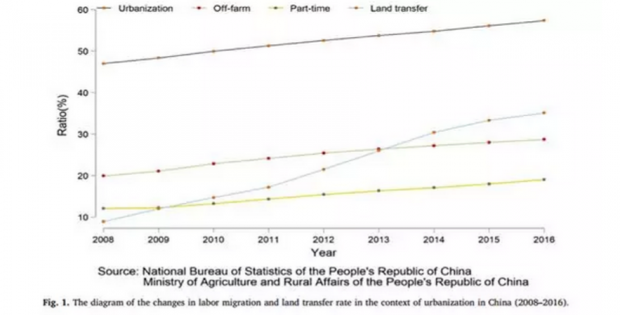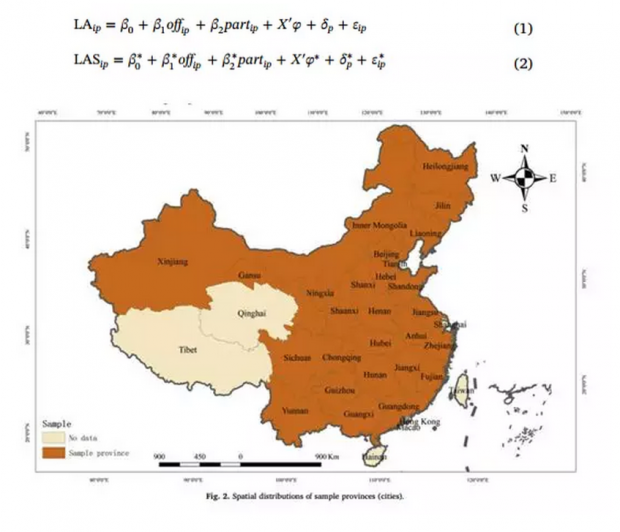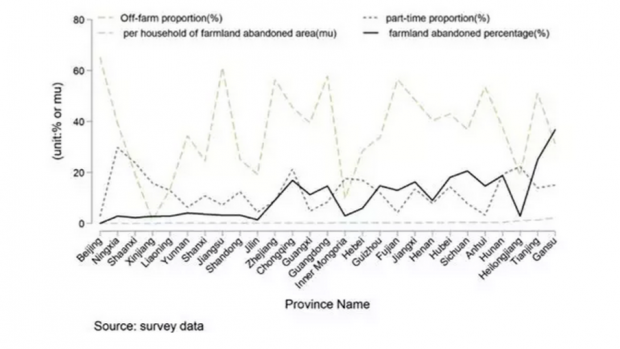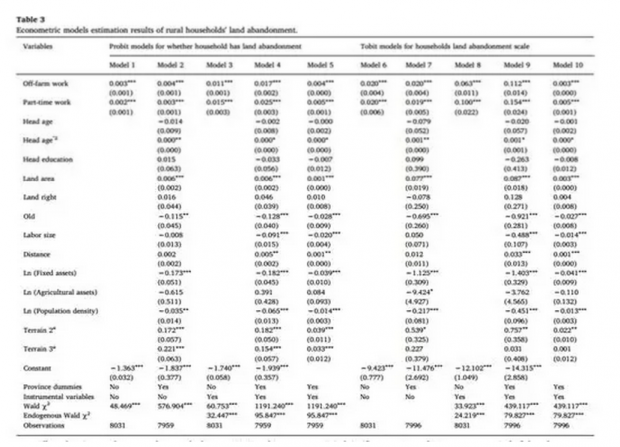阅读:0
听报道
推文人 | 邓鑫
原文信息:Xu et al. (2019). Labor migration and farmland abandonment in rural China: Empirical results and policy implications. Journal of Environmental Management.
一、引言
耕地抛荒,是一种全球性的农业景观现象。源于城镇化和工业化的带动,大量农村劳动力转移至非农部门就业。农村农业劳动力的缺失及农业生产的老龄化,加之土地利用纯收益的下降(农业生产资料成本上升)、土地制度改革及农业补贴等相关政策的调整,许多偏远、零碎、效益低的耕地被抛荒。已有研究重点关注的欧美等发达国家的耕地抛荒现状及其驱动因素,然而,对于中国这一经济快速发展,耕地抛荒现象日渐严重的国家还关注较少。耕地抛荒作为全球各国一种普遍的社会经济现象,其驱动机制研究一直是地理学、经济学、生态学等学科研究的热点。现有研究从大尺度空间视角,探索了耕地抛荒分布形态以及区域内宏观驱动机制。然而,农户是耕地利用方式的决策单元。从农户视角出发,引入社会经济要素,能够精细化探索农户耕地抛荒的驱动机制。作者认为,农村劳动力迁移是导致耕地抛荒的主要因素。然而,农村劳动力迁移又有不同的形态(非农化与兼业化),这些形态对耕地抛荒的影响是否一致呢?基于对宏观数据的分析,作者提出了两个研究问题:
(1)从空间尺度而言,中国的耕地抛荒具有怎样的空间特征?
(2)劳动力迁移(非农+兼业)对农户耕地抛荒具有怎样的定量影响?

二、数据来源及计量模型
该文数据来自于中山大学社会科学调查中心2014年组织的中国劳动力动态调查(China Labor-force Dynamic Survey,简称CLDS)。通过数据清洗整理工作,该文最终使用了其中27个省(市、自治区)226个村8031户农户的调查数据(研究选择的样本省见Fig. 2.)。
作者分别讨论了非农与兼业对耕地抛荒行为和耕地抛荒面积的影响,由此,作者设定了如下两个模型。方程(1)对应的是probit回归;方程(2)对应的是tobit回归。考虑到劳动力迁移与耕地利用之间可能存在互为因果关系,因此作者在基准回归模型之上,还考虑了使用工具变量法进行回归。随后的主要结果分析也是基于工具变量回归结果展开的。

三、结果发现
1. 劳动力转移与耕地抛荒呈现出相似的集聚趋势。
从下图可以看出,在省级层面,劳动力迁移(非农+兼业)与耕地抛荒百分比变动趋势基本一致,存在正向的相关关系。(细节可查阅原文4.2. Spatial distribution analysis of labor migration and farmland abandonment)

2. 实证结果显示劳动力迁移(无论是非农化还是兼业化),都会引起耕地抛荒。Model 1 和 Model 2 是模型的基准回归,其中,Model 2是在Model 1的基础上加入控制变量后的结果;Model 3 和 Model 4是考虑到核心自变量可能是内生变量,采用工具变量法估计的模型结果,其中,Model 4在Model 3的基础上加入控制变量后的结果;最后,Model 5是在Model 4的基础上,估计的各变量的边际效应结果(除了估计方法外,Model 6-Model 10的所有结果均与Model 1-Model 5的类似)。从估计结果来看,无论被解释变量是耕地抛荒行为还是耕地抛荒面积,非农(Off-farm work)和兼业(Part-time work)都在1%水平上显著,且系数为正。即,农村劳动力迁移会引起耕地抛荒。随后作者还是进行了相关检验以确保结果的稳健性。

四、结论与展望
作者认为:2017年,党的十九大提出“乡村振兴战略”,其核心之一就是构建人才、土地、资金在城乡间双向流动的体制机制。可以预见,未来中国广大的“乡村”会成为投资的热土,越来越多的外出劳动力会在政策的引导下选择回到农村从事三农工作。随着人才、资金的大量回流及“三权”分制土地流转制度的健全,耕地抛荒现象可能能得到根本上的遏止。在此背景下,本研究的结果可以为“乡村振兴战略”人才在城乡间的合理配置相关政策制定提供参考借鉴。
此外,作者认为该项研究也存在一些不足,可在将来的研究中进一步弥补。比如,当前,中国仍处于快速城镇化阶段,农村劳动力快速转移仍是一个长期趋势和动态过程,农业劳动力快速且持续减少对中国农户耕地抛荒有何影响需要面板数据才能更好的揭示,而本研究只是基于一个静态的时间节点(截面数据)而做的分析。将来的研究可进一步从时空动态变化上去分析农户耕地抛荒的空间分布和驱动机制,尤其关注劳动力动态迁移对农户耕地抛荒的影响。
文章原题为:中国农村劳动力转移与耕地抛荒的实证分析与政策启示
Abstract
Farmland abandonment is a universal socio-economic phenomenon in various countries in the world. However, there is a lack of the large-sample empirical research on rural households' farmland abandonment in China, and few studies have explored the quantitative influences of labor migration on rural households' farmland abandonment. This study uses the survey data of 8031 rural households from 27 provinces (cities) in China. It analyzes the spatial distribution characteristics of labor migration and farmland abandonment on the basis of provinces (cities). Moreover, it constructs the iv-probit models and the iv-tobit models to quantitatively explore the influences of off-farm employment and part-time employment on rural households' farmland abandonment. The results show that: Labor migration and farmland abandonment in various provinces (cities) of China present the trend of spatial area agglomeration. The regional differences of off-farm laborers are significant, whereas the regional differences of part-time laborers are relatively small; Labor migration would promote rural households’ farmland abandonment. When other conditions remain unchanged, with every 10% increase in off-farm employment and part-time employment, the average probability of rural households’ farmland abandonment increases by 4% and 5%, respectively, and the average farmland area that rural household abandons increases by 3% and 5%, respectively. This study can enhance the understanding of the relationship between labor migration and rural households’ farmland abandonment in China, so as to provide reference for the rational allocation of labor resources and the formulation of the policies related to ensuring food security.

话题:
0
推荐
财新博客版权声明:财新博客所发布文章及图片之版权属博主本人及/或相关权利人所有,未经博主及/或相关权利人单独授权,任何网站、平面媒体不得予以转载。财新网对相关媒体的网站信息内容转载授权并不包括财新博客的文章及图片。博客文章均为作者个人观点,不代表财新网的立场和观点。




 京公网安备 11010502034662号
京公网安备 11010502034662号 